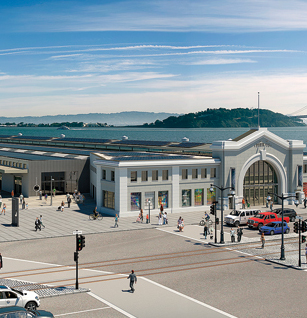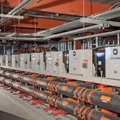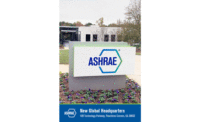The Exploratorium museum aims for net zero status with myriad sustainable technologies.The project at Pier 15 along San Francisco’s Embarcadero has the goal of becoming the largest net zero museum in the United States.

When it comes to celebrating the new Exploratorium museum project located at Pier 15 along San Francisco’s Embarcadero, the engineering and systems design professionals at Oakland, Calif.-based Integral Group tend to take it a bit personally.
“From the outset our client was determined that its new home be as sustainable as possible, so we knew the Exploratorium would be a perfect match with our own corporate commitment to green values,” project manager Joseph Wenisch says.
Wenisch notes the museum draws 500,000 visitors annually and another 26 million to its website. Attendance at the new site is estimated to exceed 1 million annually.
“Many Integral employees, including [founder and managing director] Peter Rumsey, grew up in this area and visited the Exploratorium as kids,” he says. “Now these professionals will get to enjoy it with their own families at the new, more easily accessible facility they helped design and whose commitment to sustainability they helped bring to life.”

Compelling contrast
The Exploratorium’s current home at the Palace of Fine Arts in San Francisco’s Marina District was erected nearly a century ago for the 1915 Panama-Pacific International Exposition. “No heating, no air conditioning, no ventilation, poor lighting,” Wenisch says. “But they’ve outgrown it and are now in a position to address the building issues they have struggled with for decades.”
At the heart of San Francisco’s waterfront, the newly renovated facility promises to offer an impressive assortment of architectural and engineering innovations. Built in 1931 and vacant for years, the pier has undergone a gut renovation, including major structural repairs to its pilings to make it earthquake-safe for the next century.
Slated for completion by the end of 2012, the massive construction project will yield 330,000 sq. ft. of indoor and outdoor space. The finishing touch is an all-glass observatory that anchors the back of the new complex at the end of the pier’s 800-ft. projection into the bay.
All upgrades and alterations were done within strict historical-preservation guidelines with the idea of returning the building to its original look. Some alterations, such as the addition of solar panels to the roof, won approval. Others, such as insulating the walls to prevent heat loss or gain, were disallowed.
“Historical preservation was a factor in virtually every design decision we made,” Wenisch says.

Net zero goal
When the Exploratorium becomes fully operational in spring 2013 its goal is to become the largest net zero energy museum in the United States, if not the world. True to the spirit of the Exploratorium - and the nature of net zero - achieving such an ambitious degree of energy efficiency will require monitoring and tinkering over time. The entire undertaking will be a real-time education exhibit with live energy use and photovoltaic production on public display.
“This project combines an effort to both innovate and think critically about the impact science can have on the world,” Exploratorium Executive Director Dennis Bartels, Ph.D., says. “Our net zero goal is, in part, a way to reduce our global footprint and help improve the community we’ve been a part of for more than 40 years. Net zero is a process - and an opportunity for the public to learn with us.”
Targeting LEED Gold certification, the new Exploratorium will have many notable green features, including:
Eight 50-ton Multistack water-to-water heat pumps will handle the job of raising or lowering the temperature of the bay water to meet comfort demand. These electric-chilled heaters feed a four-pipe system that carries either hot or chilled water to a 200,000-ft. network of Uponor PEX tubing embedded in concrete slabs on two levels spanning 82 different heating-cooling zones. Each zone has a control valve and a thermostat to switch between heating and cooling, based on need.
No other type of water-heating equipment is used in the building, nor is there any use of fossil fuels except for highly limited cooking purposes in a small restaurant - thus the net zero carbon designation.
“We did not wish to sacrifice comfort for energy savings on this project, and radiant is a premium comfort system,” Wenisch says.
In addition, almost half the Exploratorium is open exhibit space with 30- to 40-ft.-high ceilings. “Radiant allows us to heat and cool at the floor level where the people are, rather than attempting to condition such a large volume of air in those high-ceiling rooms,” he adds.
A third major contributor to water savings is a rainwater recapture system covering one-third of the roof area, despite all the real estate occupied by the PV system. Rainwater routes from the roof to underneath the pier and into a large storage tank that is actually part of the building’s structure. “A pile cap beneath the pier constructed to resist earthquakes contains a large cavity where the rainwater is stored until it is needed to flush toilets,” says Wenisch, who estimates the recapture system will save 300,000 gal. of water annually.

Is radiant right?
Integral began its mechanical, electrical and plumbing engineering work on the Exploratorium project in 2007, following EHDD Architecture, whose own involvement began a number of years prior. The two firms had worked on several projects with a strong green orientation, most notably the Carnegie Institution for Science (Department of Global Ecology) at Stanford University in 2004. At 11,000 sq. ft., this building is smaller than the new Exploratorium, but uses a similarly innovative radiant system that distributes heating and cooling via PEX tubing. Instead of bay water, water is sprayed on the Carnegie Institution’s roof at night and then recaptured to cool the interior during the day.
The Exploratorium aims to achieve substantial energy savings over the ASHRAE 90.1 baseline in several areas. But heating and cooling, along with lighting and pumps are expected to make the biggest contributions: a 55% savings in yearly electrical consumption for heating and 94% for cooling. Wenisch explains this is why the use of radiant slab heating and cooling was a key part of the Exploratorium plan from the outset. But it was far from a slam-dunk.
“Building ownership opted for an integrated design approach, involving all disciplines in the early programming and schematic phases of the project,” he says. “With the support of EHDD, Integral did a lot of energy modeling to demonstrate the benefits of radiant vs. a more conventional VAV reheat system and to prove the operational cost savings to the owner.”
But the engineers at Integral also needed to convince themselves radiant was the right choice. “Because most of the structure is situated over the water, there is a substantial amount of heat loss through the pier floor and into the air between the building and the bay below,” Wenisch says. “Until we did the energy modeling, we were not 100% certain we could make the radiant work.”
One of the more critical modeling exercises involved tracking the temperature of the water beneath Pier 15 for a full year to verify a demand for either heating or cooling - sometimes both simultaneously in different parts of the building - could be readily met, regardless of season. Integral documented a high-to-low range of 50° to 65°F, which turned out to be “perfect for a radiant system,” Wenisch says.
“To cool the building, we need 58° to 60° water for the slab. On the heating mode during the winter, the low-range temperatures actually boost the efficiency of the water-source heat pumps. Overall, the San Francisco Bay is a fairly stable heat source or heat sink throughout the year.”

How the system works
When the facility is operational, bay water will continuously pump in and out of the building. It first moves through low-pressure microscreen drum filters to sift particles larger than 30 microns and then circulates through an ultraviolet-ray sterilizer that keeps the system free from plant growth.
The filtered water then transfers to a 4,000-gal. concrete tank beneath the pier before moving to a pair of titanium heat exchangers. Each exchanger handles half the load during normal operations and two-thirds during maintenance periods. Depending on the need for heating or chilled water, the bay water exchanges heat with the “condenser water” circulating on the opposite side of the titanium units. Variable-speed pumps then move the condenser water to the eight chiller heaters and the 82-zone PEX tubing network embedded in the floors throughout the building.
The bay water never moves beyond the heat exchangers because salt water would corrode the heat pumps and other mechanical components in just a few months. Once the heat exchange process is complete, the bay water returns to its source - completely unchanged and with no chemical treatment as stipulated by local permitting authorities. All the above is accomplished in a single space inside Pier 15’s Bay Water Mechanical Room, whose operations will be available for viewing by museum visitors.
The system operates differently at various times of the year based on building comfort needs and bay water temperature.
Colder months: When space heating is needed, the bay functions as a heat source. The eight heat pumps use the 50° bay water to heat the hot-water return from 90° to 100° before it returns to the PEX tubing network. A valve at each of the 82 manifolds automatically controls flow into a zone, depending upon the ambient temperature of the space.
Warmer months: When cooling is required, the bay serves as a heat sink. Now functioning as chillers, the heat pumps lower the temperature of the water - from around 65° to the 60° required for cooling - before it circulates to the 82 cooling zones.
Free waterside economizer months: When the bay water temperature is below the building chilled-water return temperature, the system operates in what Integral calls its “water-side economizer mode,” Wenisch explains. “For roughly six to eight months a year, the bay water is around the optimum cooling temperature. That allows us to cool the building chilled-water loop either partially or fully bypassing the heat pumps.”
Integral expects the waterside economizer mode will yield the bulk of the cooling system energy savings by keeping the heat pump chillers idle. “In San Francisco, we are very fortunate we have very few days over 80°,” Wenisch notes. But even when the heat pumps are operational, “the chiller plant runs more efficiently because we designed the building to use a higher water temperature.”
Radiant reduces the amount of energy normally expended to blow air. “Radiant has a lot of secondary benefits, and in this project we’re trying to take full advantage of them all to minimize energy consumption,” he adds.
The dryness of the San Francisco climate obviates the need for dehumidification in all but the most heavily trafficked areas, such as the theater and the retail store inside the old pier and especially the Observatory, which houses a cafeteria-style restaurant on the lower level and an exhibition and event space above. These areas are equipped with radiant slab cooling, but when occupancy rises to several hundred people on a warm day water-to-air heat pumps will activate to dehumidify the spaces.
“The radiant system is designed to operate on 55° chilled water, which is not likely cold enough to handle peak loads especially when 500 people are gathered in the restaurant or the event room,” Wenisch says. “Rather than lower the system temperature, we opted for the water-source heat pumps. But radiant allowed us to use heat pumps one or two sizes smaller than they would have been if they were handling the spaces themselves.”
Success the second time around
The new Exploratorium is distinctive in many ways. But it is not the only renovated pier on The Embarcadero to employ radiant slab heating and cooling, nor is it the first to attempt to save water and energy by using bay water with such a system.
Completed in 2001, the renovation of Pier 1 employed these cutting-edge technologies. While the building’s heating and cooling systems have continued to function properly, there were problems with the use of bay water at the outset.
“They ended up replacing the bay water system with a cooling tower,” says Wenisch, who acknowledges the Pier 1 situation “had an impact on the planning of the Pier 15 renovation a decade later. We had to fight through the negatives associated with that earlier project.”
But he believes the bay water-driven radiant slab system at Pier 15 will avoid the problems of its counterpart a half-mile down The Embarcadero on its way to becoming “a great and long-lasting example of how to do green design.”

